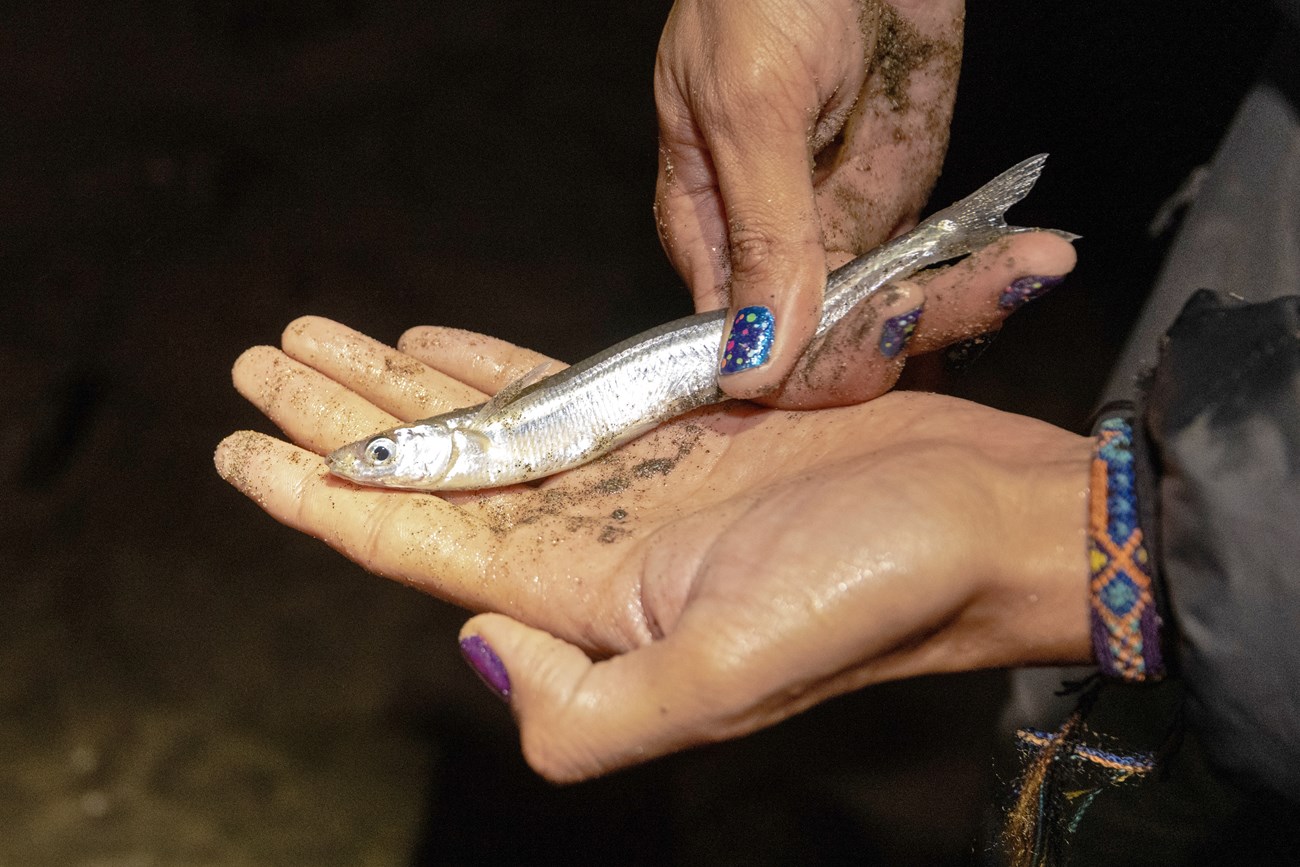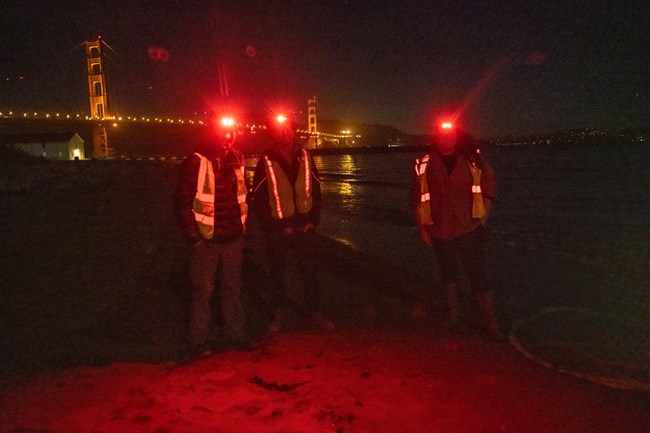Last updated: August 10, 2023
Article
Summer Moon Lures Silvery Fish Ashore to Spawn At Crissy Beach. Climate Change Had a Hand Too.
By Natural Resources Intern Maya Akkaraju, Golden Gate National Recreation Area

NPS / Jessica Weinberg McClosky

NPS / Jessica Weinberg McClosky
July 2023 - The summer sun draws beachgoers to the shore in throngs by day, and the summer moon lures the grunions out by night. These silvery fish, signaled by celestial bodies to spawn from June to August, are making their annual appearance at Crissy Beach in Golden Gate National Recreation Area.
To learn more about how these endemic California fish are doing in San Francisco Bay, park interns and volunteers also head out at night in partnership with the Grunion Greeter citizen science project to estimate the size of their spawning runs. Grunions, which only reach 4-6 inches in their adult stage, use the high tide series that follows full and new moons in the summer to swim up onto the beach. They’re easy to spot in the red beams of our headlamps.
We watch in wonder as each spawning female buries most of her body vertically in the sand, while male fish curve around her and fertilize the eggs she is laying. When they’re done, the grunions flop towards the ocean and catch the next wave back in, leaving their eggs to incubate for two weeks until the next high tide’s waves swirl the sand and pull them back into the water. The eggs, triggered by the jolting waves, hatch once they return to the ocean.
As high tide approaches, night herons monitor the shoreline as well, searching for their prey. Grunions are also prey for pelicans, terns, and “any other fish bigger than them,” said Pepperdine University Distinguished Professor Emeritus of Biology and Grunion Greeter Project Executive Director Karen Martin.

NPS / Jessica Weinberg McClosky
Grunions come to Crissy Beach in the hundreds, but they spawn at Southern California beaches in the thousands. It wasn’t until 2005 that grunions were first spotted in the Bay Area, when Martin says they may have followed a pulse of warm water up from Southern California.
The Bay Area population of grunions then blinked out after the 2007 Cosco Busan oil spill and didn’t return until around 2012. Martin believes warming ocean temperatures and blobs of warmer water allowed grunions to colonize the Bay Area a second time.

NPS / Jessica Weinberg McClosky
Once in the bay, grunions are isolated from their other coastal neighbors — the open ocean is too cold at this latitude for them to survive. Outside of the summer spawning season, Martin believes local grunions reside in the deeper parts of the bay.
Within the Bay Area, Crown Beach in Alameda is another known grunion spawning spot. Martin suspects they may also be spawning at other local sandy beaches that haven’t been monitored yet.
The Bay Area presents its inhabitants with their fair share of stressors. A harsh environment with varying salinity and craggy shores shortens their lifespan and makes the grunions smaller than those in Southern California. Most of the fish here are 1-year olds, while spawners further south reach 2- to 4-years old.
In addition to their aquatic habitat challenges, grunions have particular requirements for the beaches they’ll frolic in. The coarse, rocky shores dotted along Northern California will simply not do — grunions need sand to lay their eggs in. Despite the difficulties, our late-night surveys indicate that the bay’s population is stable and established.
Grunions expanded their range to the San Francisco Bay — and to their northernmost habitat in Tomales Bay — as a direct result of climate change. The warming oceans and shores will continue to push them north, Martin said.

NPS / Jessica Weinberg McClosky
“The maximum temperature for the eggs is 28 degrees Celsius, we’re already pushing it even in the heart of their range in Southern California,” Martin said. “The only place they spawn is on shore, as that becomes less and less hospitable, they have to move north.”
The grunion’s adaptations to their changing environment are already apparent locally with their smaller body size. As climate change continues and the habitat available to them shifts, they will need to continue adapting and moving.
“They are a unique endemic fish only found in California,” Martin said. “It’s kind of the ultimate California fish. They surf, go to the beach, they’re party animals.”
For more information
- Visit Grunion.Org to learn more about California grunion and the Grunion Greeter Project
- Visit California Department of Fish and Wildlife’s Grunion page for spawning run information and more fun grunion facts
See more from the Bay Area Nature & Science Blog
